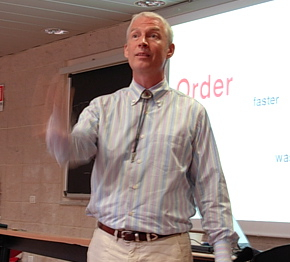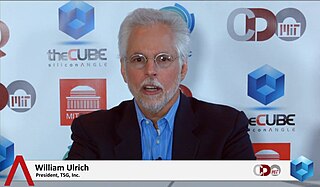Related Research Articles

The Object Management Group (OMG) is a computer industry standards consortium. OMG Task Forces develop enterprise integration standards for a range of technologies.

The unified modeling language (UML) is a general-purpose visual modeling language that is intended to provide a standard way to visualize the design of a system.
The following outline is provided as an overview of and topical guide to software engineering:
A consultant is a professional who provides advice or services in an area of specialization. Consulting services generally fall under the domain of professional services, as contingent work.

Computer-aided software engineering (CASE) is a domain of software tools used to design and implement applications. CASE tools are similar to and are partly inspired by computer-aided design (CAD) tools used for designing hardware products. CASE tools are intended to help develop high-quality, defect-free, and maintainable software. CASE software was often associated with methods for the development of information systems together with automated tools that could be used in the software development process.

Craig Larman is a Canadian computer scientist, author, and organizational development consultant. With Bas Vodde, he is best known for formulating LeSS, and for several books on product and software development.

Business process modeling (BPM), mainly used in business process management; software development, or systems engineering, is the action of capturing and representing processes of an enterprise, so that the current business processes may be analyzed, applied securely and consistently, improved, and automated. BPM is typically orchestrated by business analysts, leveraging their expertise in modeling practices. Subject matter experts, equipped with specialized knowledge of the processes being modeled, often collaborate within these teams. Alternatively, process models can be directly derived from digital traces within IT systems, such as event logs, utilizing process mining tools.

Edward Nash Yourdon was an American software engineer, computer consultant, author and lecturer, and software engineering methodology pioneer. He was one of the lead developers of the structured analysis techniques of the 1970s and a co-developer of both the Yourdon/Whitehead method for object-oriented analysis/design in the late 1980s and the Coad/Yourdon methodology for object-oriented analysis/design in the 1990s.
A functional software architecture (FSA) is an architectural model that identifies enterprise functions, interactions and corresponding IT needs. These functions can be used as a reference by different domain experts to develop IT-systems as part of a co-operative information-driven enterprise. In this way, both software engineers and enterprise architects can create an information-driven, integrated organizational environment.
Object-oriented analysis and design (OOAD) is a technical approach for analyzing and designing an application, system, or business by applying object-oriented programming, as well as using visual modeling throughout the software development process to guide stakeholder communication and product quality.
Oracle Fusion Middleware consists of several software products from Oracle Corporation. FMW spans multiple services, including Java EE and developer tools, integration services, business intelligence, collaboration, and content management. FMW depends on open standards such as BPEL, SOAP, XML and JMS.
David McGoveran is an American computer scientist and physicist, software industry analyst, and inventor. In computer science, he is recognized as one of the pioneers of relational database theory.
Business Process Modeling Language (BPML) is an XML-based language for business process modeling. It was maintained by the Business Process Management Initiative (BPMI) until June 2005 when BPMI and Object Management Group announced the merger of their respective business process management activities to form the Business Modeling and Integration Domain Task Force. It is deprecated since 2008. BPML was useful to OMG in order to enrich UML with process notation.
Scott W. Ambler is a Canadian software engineer, consultant and author. He is an author of books about the Disciplined Agile Delivery toolkit, the Unified process, Agile software development, the Unified Modeling Language, and Capability Maturity Model (CMM) development.
Enterprise engineering is the body of knowledge, principles, and practices used to design all or part of an enterprise. An enterprise is a complex socio-technical system that comprises people, information, and technology that interact with each other and their environment in support of a common mission. One definition is: "an enterprise life-cycle oriented discipline for the identification, design, and implementation of enterprises and their continuous evolution", supported by enterprise modelling. The discipline examines each aspect of the enterprise, including business processes, information flows, material flows, and organizational structure. Enterprise engineering may focus on the design of the enterprise as a whole, or on the design and integration of certain business components.
Business process management (BPM) is the discipline in which people use various methods to discover, model, analyze, measure, improve, optimize, and automate business processes. Any combination of methods used to manage a company's business processes is BPM. Processes can be structured and repeatable or unstructured and variable. Though not required, enabling technologies are often used with BPM.
Subject-oriented business process management (S-BPM) is a communication based view on actors, which compose a business process orchestration or choreography. The modeling paradigm uses five symbols to model any process and allows direct transformation into executable form.

William M. Ulrich is an American business architecture consultant, consultant at Cutter Consortium, director and lecturer, known for development of 'The Systems Redevelopment Methodology' (TSRM) in the 1990s, on legacy systems in the 2000s and more recently on his work on business architecture.
Michael Rosen is an American enterprise architect, and management consultant, known for his work on Common Object Request Broker Architecture (1998), and Applying service-oriented architecture.

Michael Rosemann is a German information systems researcher and professor at the Queensland University of Technology, Brisbane, Australia. He is currently the director of the Centre for Future Enterprise at QUT. His research interests include revenue resilience, business process management, trust management and innovation systems. Rosemann is also the honorary consul of the Federal Republic of Germany in Southern Queensland.
References
- ↑ Luger, George F., and William A. Stubblefield. Artificial intelligence and the design of expert systems. Benjamin-Cummings Publishing Co., Inc., 1990.
- ↑ Jackson, Cynthia M., Simeon Chow, and Robert A. Leitch. "Toward an understanding of the behavioral intention to use an information system." Decision sciences 28.2 (1997): 357-389.
- ↑ zur Muehlen, Michael, and Michael Rosemann. "Integrating risks in business process models." Proceedings of the 2005 Australasian Conference on Information Systems (ACIS 2005), Manly, Sydney, Australia. 2005.
- ↑ Rosemann, Michael, Jan Recker, and Christian Flender. "Contextualisation of business processes." International Journal of Business Process Integration and Management 3.1 (2008): 47-60.
- ↑ Paul Harmon, and Celia Wolf(2009). Paul Harmon Archived 2008-12-23 at the Wayback Machine at bptrends.com